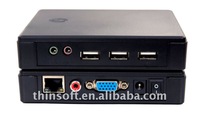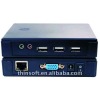Network Terminal NC120 Network Terminal NC120 Enables sharing one host PC with up to 30 users* - Connects to host PC via Ethe
Network Terminal NC120
With the demand of the company and the individuation terminal users requested, the increase of consciousness of benefit direction detection, reducing cost and computer serving market. The times has passed that standard computer can solve all of the problems, terminal service/thin-body commuter have been invented successfully and realized all of the functions at low cost. At mean time, they are more environmental protection and more security. They are different completely between thin-body computer market and traditional one. Network Terminal NC120 will promote and open new terminal market of integrating all of input and operating. The operation based on service is complex. If you intend to expand your computer, NC120 is your first choice.
NC120 is the independent terminal based on network; it is the first computer terminal without CPU. HD and CD-ROM. It combined the UTMA technology and the advanced SOC chip algorithm which Net Computer is in sole possession of, realized many users to share the resources of the host computer, such as CPU, memory, hard disk, driver. The operation is the same as that of the host. It connects with the host or server by TCP/IP Ethernet. One host can support ten NC120 terminals (windows 2000/2003/XP, server edit can support 30 ones at most), and each user can simultaneously share the host recourses independently and securely. NC120 is widely suitable for officehospitalcall centertraining centerlibrarycoffee etc.
Key Features- Enables sharing one host PC with up to 30 users* - Connects to host PC via Ethernet over any distance- Includes terminal services software for Windows/Linux- Extension protocol supports multi-media applications- Slashes computing acquisition & support costs- Easy to setup, maintain and secure- Compact, reliable & energy efficient (no fans or disks) - Zero-footprint monitor mount- All in a stylish new smaller chassis (just 1 inch tall and 4.5 inches square)
HARDWARESize Length: 120 mm / 4.5 inches, Width: 120 mm / 4.5 inches, Height: 26 mm / 1 inchesWeight: 154 g / 0.34 lbs Shipping Weight (includes power adapter, packaging, documentation, etc.): 0.76 kg / 1.6 lbsPower SupplyInput: 100-250 VAC, 50-60 HzOutput: 5 VDC, 2 ANominal consumption: 4.5 WattsFront LED IndicatorsPower: connection to power supplyLAN: connection to networkReady: connection to host PCRear Ports
Advantages:Obviously,boot image control is much simpler when only Net Computer are used typically a single boot image can accommodate a very wide range of user needs, and be managed centrally, resulting in:
Lower IT administration costs. Net Computer are managed almost entirely at the server. The hardware has fewer points of failure and the client is simpler (and often lacks permanent storage), providing protection from malware.
Easier to secure. Net Computer can be designed so that no application data ever resides on the client (just whatever is displayed), centralizing malware protection and reducing the risks of physical data theft.
Enhanced data security. Should a Net Computer device suffer serious mishap or industrial accident, no data will be lost, as it resides on the terminal server and not the point-of-operation device.
Lower hardware costs. Net Computer hardware is generally cheaper because it does not contain a disk, application memory, or a powerful processor. They also generally have a longer period before requiring an upgrade or becoming obsolete. The total hardware requirements for a thin client system (including both servers and clients) are usually much lower compared to a system with fat clients. One reason for this is that the hardware is better utilized. A CPU in a fat workstation is idle most of the time. With thin clients, memory can be shared. If several users are running the same application, it only needs to be loaded into RAM once with a central server. With fat clients, each workstation must have its own copy of the program in memory.
Less Energy Consumption. Dedicated Net Computer hardware has much lower energy consumption than thick client PCs. This not only reduces energy costs but may mean that in some cases air-conditioning systems are not required or need not be upgraded which can be a significant cost saving and contribute to achieving energy saving targets. However, more powerful servers and communications are required.
Easier hardware failure management. If a Net Computer fails, a replacement can simply be swapped in while the client is repaired; the user is not inconvenienced because their data is not on the client.
Worthless to most thieves. Net Computer hardware, whether dedicated or simply older hardware that has been repurposed via cascading, is useless outside a client-server environment. Burglars interested in computer equipment have a much harder time fencing thin client hardware (and it is less valuable).
Operable in Hostile Environments. Net Computer have no moving parts so can be used in dusty environments without the worry of PC fans clogging up and overheating and burning out the PC.
Less network bandwidth. Since terminal servers typically reside on the same high-speed network backbone as file servers, most network traffic is confined to the server room. In a fat client environment if you open a 10MB document that's 10MB transferred from the file server to your PC. When you save it that's another 10MB from your PC to the server. When you print it the same happens again another 10MB over the network to your print server and then 10MB onward to the printer. This is highly inefficient. In a Net Computer environment only mouse movements, keystrokes and screen updates are transmitted from/to the end user. Over efficient protocols such as ICA or NX this can consume as little as 5 kbit/s bandwidth.
More efficient use of computing resources. A typical thick-client will be specified to cope with the maximum load the user needs, which can be inefficient at times when it is not used. In contrast, thin clients only use the exact amount of computing resources required by the current task in a large network, there is a high probability the load from each user will fluctuate in a different cycle to that of another user (i.e. the peaks of one will more than likely correspond, time-wise, to the troughs of another.
Simple hardware upgrade path. If the peak resource usage is above a pre-defined limit, it is a relatively simple process to add another rack to a blade server (be it power, processing, storage), boosting resources to exactly the amount required. The existing units can continue to serve alongside the new, whereas a thick client model requires an entire desktop unit be replaced, resulting in down-time for the user, and the problem of disposing of the old unit.
Lower noise. The aforementioned removal of fans reduces the noise produced by the unit. This can create a more pleasant and productive working environment.
Less Wasted Hardware. Computer hardware is very environmentally damaging. Thin clients can remain in service longer and ultimately produce less surplus computer hardware than an equivalent thick client installation.
Network Terminal NC120












